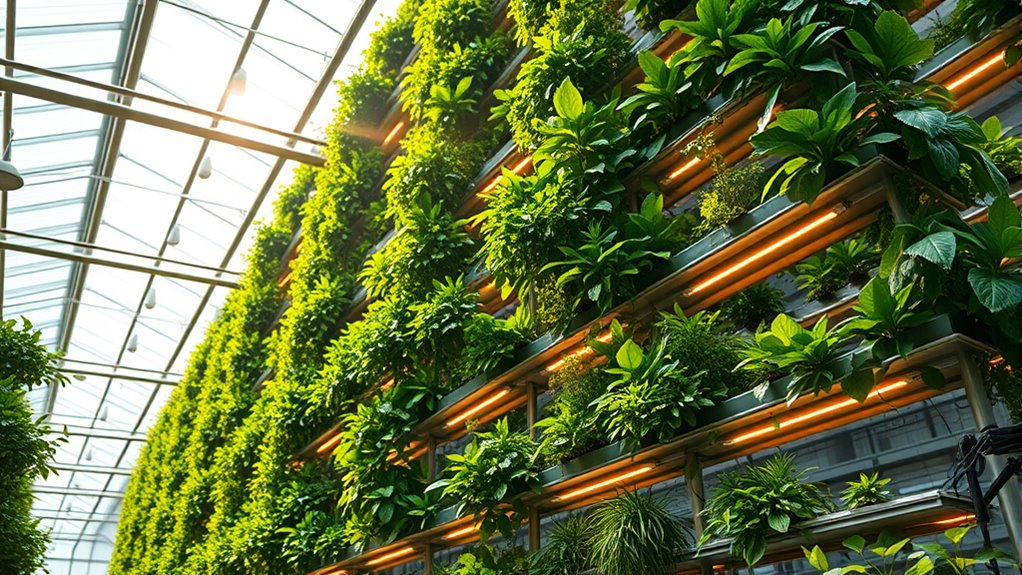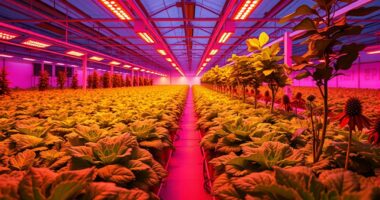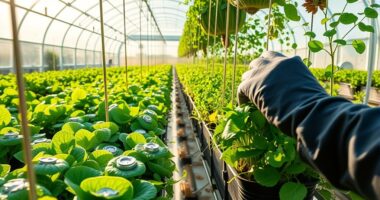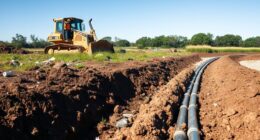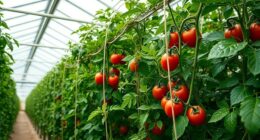Vertical farming in greenhouses helps you maximize space by stacking crops and integrating advanced technologies like LED lighting, hydroponics, and automation. This setup reduces land use, cuts transportation costs, and enables year-round production right in urban areas. Proper design—including efficient lighting and climate control—ensures healthy, high yields across all levels. If you keep exploring, you’ll discover how to overcome challenges and harness future trends in urban agriculture.
Key Takeaways
- Utilize vertical stacking of crop beds to maximize limited greenhouse space efficiently.
- Incorporate modular, scalable systems for easy expansion and optimal space utilization.
- Implement automated lighting and climate controls to ensure uniform growth across all levels.
- Use hydroponic or aeroponic systems to maximize plant density without soil constraints.
- Design flexible layouts that accommodate different crop types and optimize airflow and access.
Benefits of Vertical Greenhouse Farming

Vertical greenhouse farming offers numerous benefits that make it an increasingly popular choice for modern agriculture. One major advantage is urban integration, allowing you to bring food production closer to city centers. This reduces transportation costs, lowers your carbon footprint, and ensures fresher produce for local consumers.
Additionally, vertical setups enable you to maximize limited space by stacking crops vertically, making efficient use of available land. This approach also promotes crop diversity, giving you the flexibility to grow a wide variety of vegetables, herbs, and fruits in a single facility.
As a result, you can meet diverse market demands while maintaining year-round production. Overall, vertical greenhouses enhance your ability to produce more with less space, making urban agriculture sustainable and highly productive.
Key Technologies Powering Vertical Greenhouses
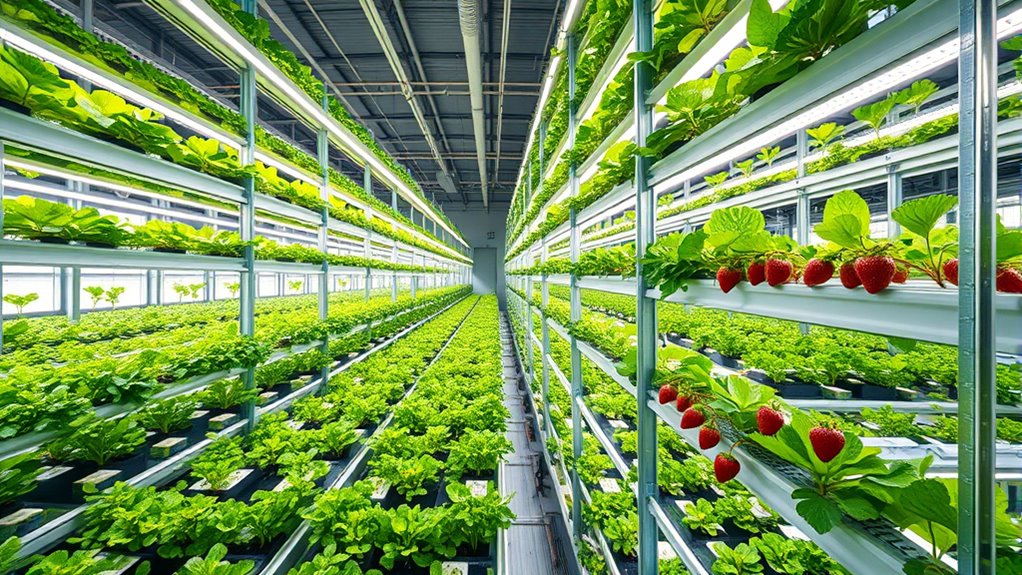
Advances in technology are the backbone of successful vertical greenhouse farming, enabling you to maximize plant growth and resource use. Key innovations include LED lighting, which provides targeted, energy-efficient illumination, and hydroponic systems that deliver nutrients directly to plant roots without soil. These technologies work together to expand space and yield while minimizing water and energy consumption. Imagine vibrant, healthy plants thriving under customized LED spectra, all within a compact vertical setup. Hydroponics ensures rapid growth and high productivity, making your greenhouse more sustainable. The table below highlights how these technologies evoke emotion and efficiency:
| Technology | Impact | Benefits |
|---|---|---|
| LED Lighting | Personalized growth boost | Energy savings, optimal light |
| Hydroponic Systems | Precise nutrient delivery | Faster growth, less water |
| Automation | Seamless operation | Reduced labor, increased yield |
| Climate Control | Perfect environment | Consistent quality |
Additionally, lighting spectrum management plays a crucial role in optimizing plant health and maximizing yields.
Designing Efficient Vertical Farming Systems
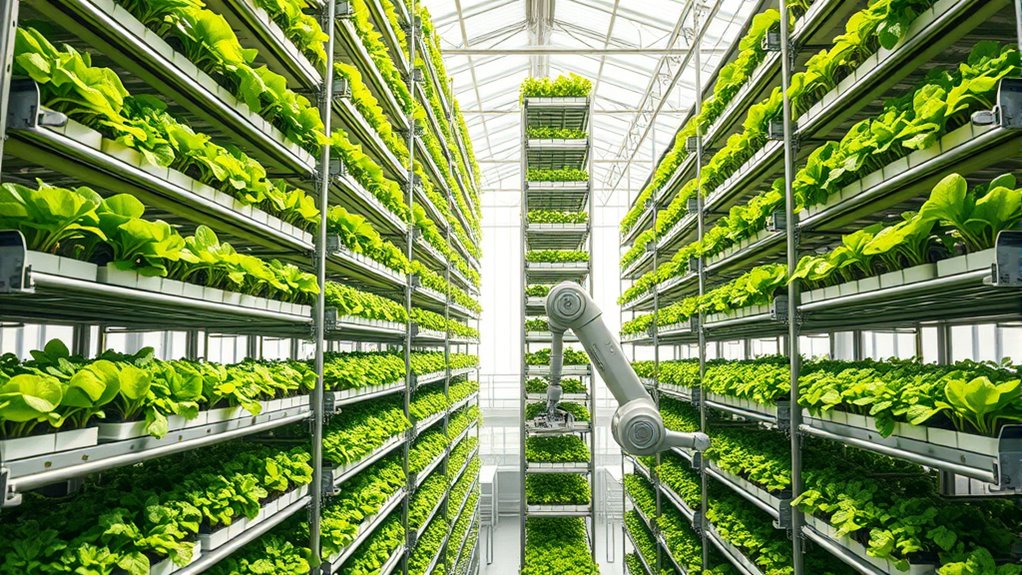
Creating an efficient vertical farming system requires careful integration of design principles that maximize space, optimize resource use, and guarantee ease of operation.
To achieve this, you should incorporate automated irrigation systems that deliver water precisely where needed, reducing waste and labor.
Nutrient delivery must be carefully managed, ensuring plants receive the right nutrients at the right time through automated systems that adjust based on plant requirements.
Structuring your setup with modular, scalable components allows for flexibility and easy maintenance.
Proper lighting and ventilation are also essential to promote healthy growth.
Challenges and Solutions in Vertical Greenhouse Cultivation

Implementing efficient vertical greenhouse systems presents unique challenges that can impact productivity and sustainability. You need to focus on lighting optimization to ensure plants receive adequate light at every level, which can be tricky in dense setups. Proper lighting distribution is essential for uniform plant growth across layers. Pest management becomes more complex as pests can spread quickly through stacked layers, requiring vigilant monitoring. Additionally, maintaining uniform conditions across different tiers can be difficult, affecting plant health. To tackle these issues, consider: – Using adjustable LED lighting for targeted, energy-efficient illumination. – Implementing integrated pest management strategies to prevent infestations. – Installing sensors to monitor temperature, humidity, and light levels for consistent conditions. – Ensuring even light distribution across all levels is crucial for healthy plant growth and maximizing yield potential. Moreover, utilizing environmental controls can help maintain optimal growing conditions throughout the vertical system. Proper storage of supplies and harvested crops also plays a vital role in the overall efficiency of vertical farming operations. Additionally, understanding and managing energy costs is essential to keep operations sustainable and economically viable.
Future Trends in Space-Maximizing Agriculture
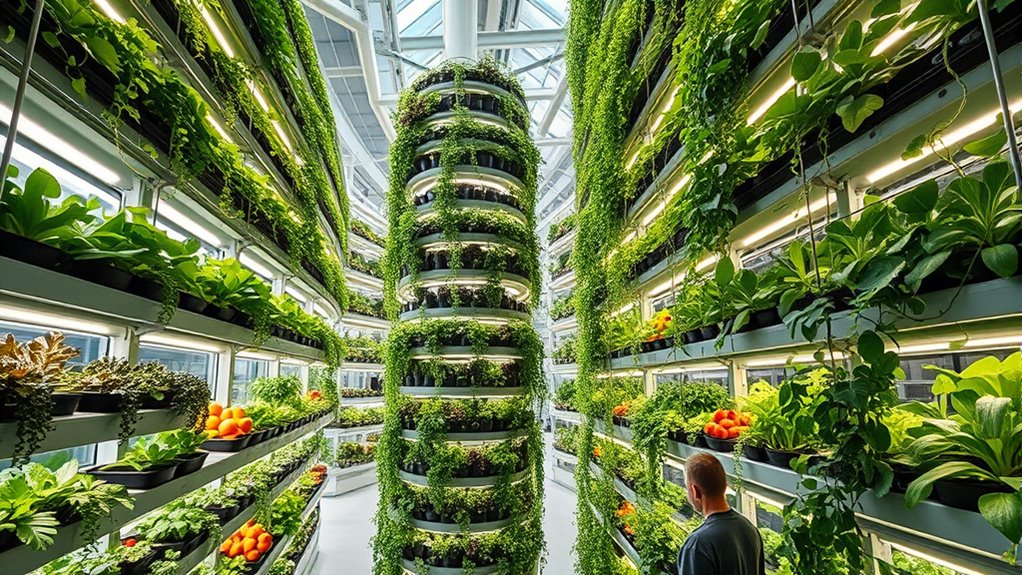
As urban areas continue to expand and arable land becomes increasingly limited, future trends in space-maximizing agriculture focus on innovative methods that make the most of every square meter. Urban integration will play a key role, with green rooftops and vertical farms becoming essential components of cityscapes. You’ll see advanced resource management techniques, such as precision irrigation and renewable energy use, to optimize efficiency. Modular, scalable systems will allow you to adapt to different spaces and needs, reducing waste and increasing productivity. Smart technology, including AI and IoT, will enable real-time monitoring and adjustments, ensuring resources are used effectively. Additionally, implementing natural techniques such as organic farming methods and cover cropping can further improve sustainability and soil health in urban farming systems. These methods also support soil fertility and long-term productivity, helping to sustain urban agricultural practices. Moreover, integrating sustainable practices will further enhance the long-term viability of urban farming initiatives, helping to conserve resource management and reduce environmental impact. Incorporating innovative design strategies can optimize space and improve airflow, which are crucial for plant health and yield.
Frequently Asked Questions
How Do Vertical Greenhouses Impact Local Biodiversity?
Vertical greenhouses can positively impact local biodiversity by supporting urban ecosystems and conserving native species. You might find that they create habitats that attract beneficial insects and pollinators, boosting plant diversity.
However, if not managed properly, they could introduce invasive species or disrupt native habitats. By carefully integrating native species and maintaining ecological balance, you can enhance biodiversity while benefiting from the efficiency of vertical farming.
What Are the Optimal Crop Choices for Vertical Greenhouse Farming?
Perfectly pairing crop selection with innovative growing techniques is key to vertical greenhouse success. You should choose crops like leafy greens, herbs, and strawberries, which thrive in stacked settings. These choices maximize yield, minimize resource use, and guarantee quick, quality harvests.
How Does Energy Consumption Vary in Vertical vs. Traditional Greenhouses?
You’ll find that energy consumption in vertical greenhouses often differs from traditional ones. Vertical setups tend to optimize space, which can boost energy efficiency by reducing the need for extensive heating, cooling, and lighting.
However, they might use more power for vertical lighting and automation systems. Overall, vertical farms can be more energy-efficient if managed properly, but they still require careful control of power consumption to maximize sustainability and cost-effectiveness.
What Are the Best Practices for Pest Control in Vertical Systems?
To control pests effectively, you should implement integrated pest management (IPM) strategies, combining monitoring, cultural practices, and targeted treatments.
Biological control is a key practice, introducing natural predators to keep pest populations in check without chemicals.
Regular inspection, maintaining cleanliness, and promoting plant health also help prevent infestations.
These practices guarantee a sustainable, pest-free environment, maximizing crop yield and quality in your vertical system.
Can Vertical Greenhouses Be Integrated With Renewable Energy Sources?
Think of your vertical greenhouse as a symphony, where renewable energy sources like solar panels and wind turbines play vital roles. You can seamlessly integrate renewable energy into your setup, boosting energy sustainability and reducing reliance on grid power.
This renewable integration not only cuts costs but also makes your vertical farming system more eco-friendly. With careful planning, you’ll create a resilient, efficient environment that thrives on clean, sustainable energy.
Conclusion
By adopting vertical farming in greenhouses, you can drastically boost space efficiency—up to 10 times more crop yield per square foot. This innovative approach not only conserves land but also reduces water usage and energy costs. As technology advances, expect even greater gains in productivity and sustainability. Embracing these methods now puts you at the forefront of future-proof agriculture, helping to feed a growing population while minimizing environmental impact.
